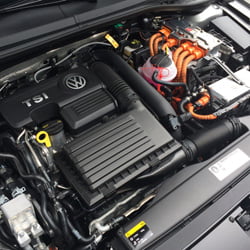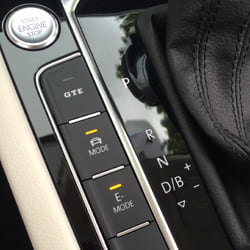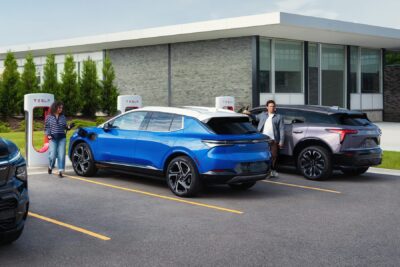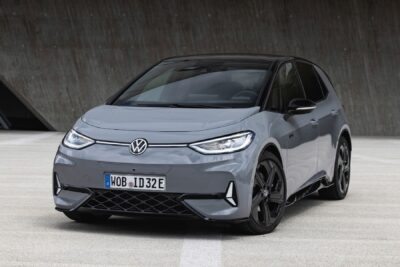VW Passat GTE: The king among company cars electrified.

It was back in 1973 that the Passat was first introduced. That was way before the author of this text was even born. Some 42 years later, the car’s eighth generation is the first to be able to drive purely electric – it is a plug-in hybrid with the token GTE. electrive’s Editor-in-Chief Peter Schwierz took the vehicle for a first test spin in Holland.
* * *
I have to admit, I was a little irritated when a VW Passat passed me in the parking garage at Schiphol Airport in Amsterdam without making sound. But yes – the Passat has finally arrived in the age of electric mobility! That is, the car that shapes Germany’s streets like no other and is next to the Golf one of Volkswagen’s most sold vehicles. And now, the favourite car of department and agency managers, as well family fathers also drives electric. On paper, the plug-in hybrid can go 50km on charge (in everyday life, it will most likely be closer to 45km). A first experience on the streets around Amsterdam shows that, when passing bike riders, for example, even the electric mobility adept Dutch look puzzled when the Passat approaches them silently.
ALL-ELECTRIC UP TO A 130
And what is it like to drive the Passat GTE? The adverb “confident” may describe it best. From a standstill, the Passat speeds up to 130 kph electrically. Then, the 1.4 litre TSI takes over. “Only when the battery is not sufficiently charged or the outside temperature is too low will the TSI engine take over immediately,” VW writes in its accompanying press release.  The lithium-ion battery with cells from Samsung is located in the rear and can hold 9.9 kWh. The permanent-magnet synchronous motor boasts 85kW and gets the 1.7-ton vehicle going. After all, this is no small car pulling away from the traffic light. Overall, the plug-in hybrid drivetrain shows no shortcomings. The switch between drive modes may not yet be as smoots as with a Toyota Prius, but is still fluid. Only when breaking at a red light shakes the 6-speed dual-clutch gearbox (DSG) the car ever so slightly. Or could it be the specially developed electromechanical Brake Booster (eBKV)? Looking under the hood makes one thing clear: during packing, VW engineers had their work cut out for them. The on-board charger (on the far right in the picture) and power electronics (top right) needed to find space aside the combustion engine. There is literally no room to fit anything else.
The lithium-ion battery with cells from Samsung is located in the rear and can hold 9.9 kWh. The permanent-magnet synchronous motor boasts 85kW and gets the 1.7-ton vehicle going. After all, this is no small car pulling away from the traffic light. Overall, the plug-in hybrid drivetrain shows no shortcomings. The switch between drive modes may not yet be as smoots as with a Toyota Prius, but is still fluid. Only when breaking at a red light shakes the 6-speed dual-clutch gearbox (DSG) the car ever so slightly. Or could it be the specially developed electromechanical Brake Booster (eBKV)? Looking under the hood makes one thing clear: during packing, VW engineers had their work cut out for them. The on-board charger (on the far right in the picture) and power electronics (top right) needed to find space aside the combustion engine. There is literally no room to fit anything else.
SPOILT FOR CHOICE
If you look more deeply into what the GTE has to offer, things get a little more challenging. There are three driving modes – electric, hybrid, and battery-charge.  And then there is the button of all buttons – the GTE knob. When pressing it, the Passat throws everything the electric motor and TSI have to offer to the front. The 400 newton metres are fun, but loud. And it has little to do with electric mobility. Still, the above mentioned mangers and family fathers will most likely appreciate the acceleration during take over. But that is not all: you can also choose between eco, comfort, normal, sport and individually configured settings. And the degree of recuperation also wants to be adjusted by putting the gear lever into position (B). That is all great, but could be a bit much for the average user. We already noted this constant spoil of choice when test driving the Audi A3 e-tron, which features a similar drivetrain. Sometimes less is simply more.
And then there is the button of all buttons – the GTE knob. When pressing it, the Passat throws everything the electric motor and TSI have to offer to the front. The 400 newton metres are fun, but loud. And it has little to do with electric mobility. Still, the above mentioned mangers and family fathers will most likely appreciate the acceleration during take over. But that is not all: you can also choose between eco, comfort, normal, sport and individually configured settings. And the degree of recuperation also wants to be adjusted by putting the gear lever into position (B). That is all great, but could be a bit much for the average user. We already noted this constant spoil of choice when test driving the Audi A3 e-tron, which features a similar drivetrain. Sometimes less is simply more.
ELECTRIC REPLENISHMENT
 The Passat GTE can be charged using the standard cable at a single-phase, 2.3 kW AC outlet at home (are you still allowed to write that in 2015?) in about four hours and 15 minutes, or in two and half hours at a wallbox or public charger. Here, we should mention Volkswagen Financial Services’ Charge&Fuel Card, which gives drivers access to and a method of payment for 1,200 chargers and 10,800 petrol stations in Germany. By the way, the inlet of the Passat GTE is located next to the VW emblem on the car grille. That may not be the ideal position when driving up to of many of the already installed public charging stations, however, most drivers will probably choose to charge at home overnight anyway.
The Passat GTE can be charged using the standard cable at a single-phase, 2.3 kW AC outlet at home (are you still allowed to write that in 2015?) in about four hours and 15 minutes, or in two and half hours at a wallbox or public charger. Here, we should mention Volkswagen Financial Services’ Charge&Fuel Card, which gives drivers access to and a method of payment for 1,200 chargers and 10,800 petrol stations in Germany. By the way, the inlet of the Passat GTE is located next to the VW emblem on the car grille. That may not be the ideal position when driving up to of many of the already installed public charging stations, however, most drivers will probably choose to charge at home overnight anyway.

CONCLUSION
The nearly four hours of driving the GTE during its presentation in Amsterdam were of course not enough to paint a complete picture, but one thing is sure: the Passat GTE presents company car drivers with a new option. With a price tag of 44,250 euros and 45,250 euros for the Variant, it may not be the cheapest option, but could be a first point of contact with electric mobility. Commuting to work electrically or the driving across the country – all is possible with the king of company cars. We will have to wait and see if fleet managers accept the GTE – or if they will stick with diesel. The “self-igniter” (from 29,125 euros) will remain the GTE’s biggest competitor. After all, the plug-in hybrid can be found on the top end of price table. The final message for all, who can stomach the mark-up: the Passat can now drive electric. And it will therefore make at least a small difference in the VW-feeling on Germany’s streets.
Text and images: Peter Schwierz
Translation: Carla Westerheide




0 Comments